

Remembering Ron Colson
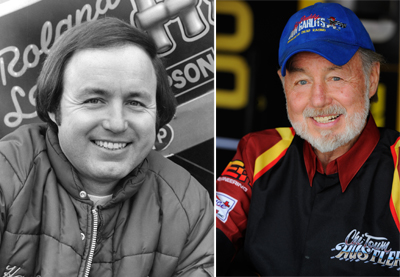
If your association with drag racing goes back four decades, it’s a pretty good bet that you know who Ron Colson was, and a fairly good bet that your paths had crossed at one point. Colson, who drove Top Fuel dragsters and Funny Cars for decades and followed with successful businesses in television publishing and consultations, died March 19. The longtime friend to so many of us in the sport had been in ill health over the past year, then was involved in a February automobile accident that only exacerbated those issues.
Although it had been years since we talked, my connection with Ron spanned decades. His driving career ended in 1980, two years before I joined the NHRA National Dragster staff, but because Colson had a drag racing publication of his own that eventually gifted the ND staff with my longtime running buddy and right-hand man Kevin McKenna, there’s a lot of connections, but we’ll get to that later.
Colson’s racing career began, like so many, as a fan, when he attended the 1957 ATAA World Series of Drag Racing at Cordova Dragway in his native Illinois. He was from the small town of Oregon, Ill., and the sport opened the doors that would see his name and his accomplishments shared from coast to coast.
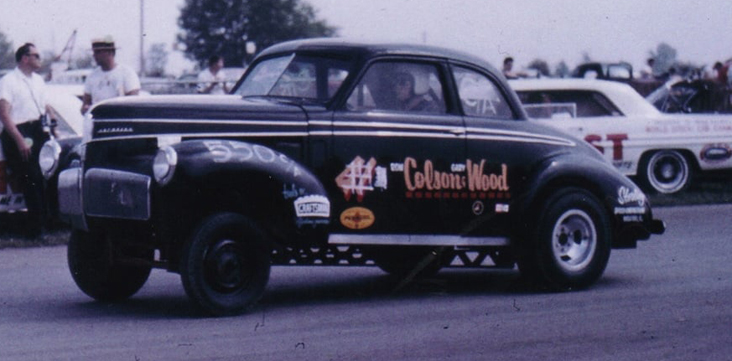
A year after seeing the drags at Cordova, Colson was driving down the famed track, starting with his sister’s ’57 MG roadster that ran in D/Sports. Within a few years, he moved into the Gas classes with partner Gary Wood in a record-setting injected small-block-powered 11-second Studebaker.
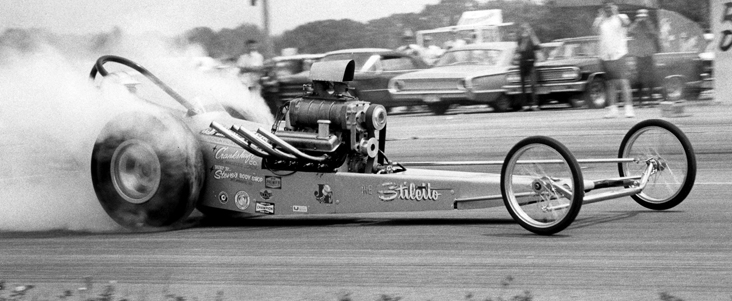
Blown gas dragsters were the obvious next evolution, starting with the Don Garlits chassised Colson-Woods-Peterson entry with Wood and future Top Fuel partner Ken Peterson. The car’s pointed nosepiece earned its “Stilleto” nickname and ran low eights at 190 mph and won the Drag News Invitational at U.S. 30 Dragway, in Gary, Ind.
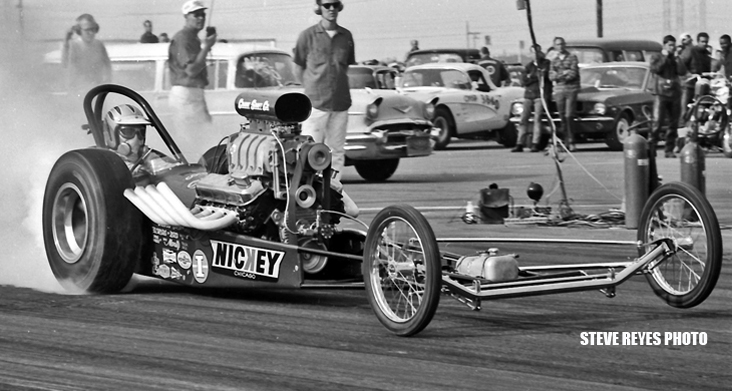
Colson continued to forge a name for himself in AHRA competition with his Nickey Chevrolet-sponsored gas-powered entry.
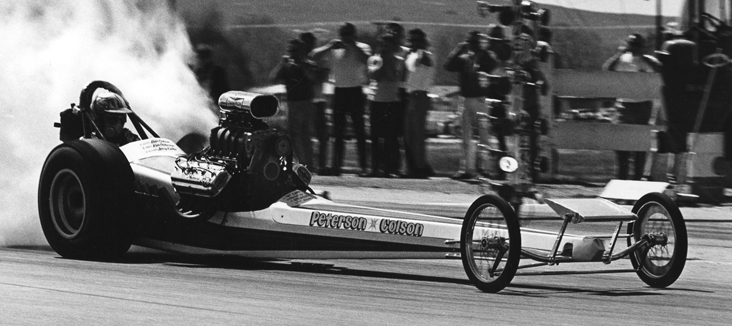
Colson graduated to Top Fuel in 1968, and he drove and won with a number of front-engine cars, including his own entry with Peterson, and eventually won the 1969 United Drag Racers Association Top Fuel championship. Dennis Friend has a ton more Colson photos on this tribute page.
(Colson had been a strong advocate for UDRS from its inception in 1963 through its eventual dormancy after 2010, acting as administrator and vice president for the UDRA for four decades, and helped produce every aspect of the group’s events.)
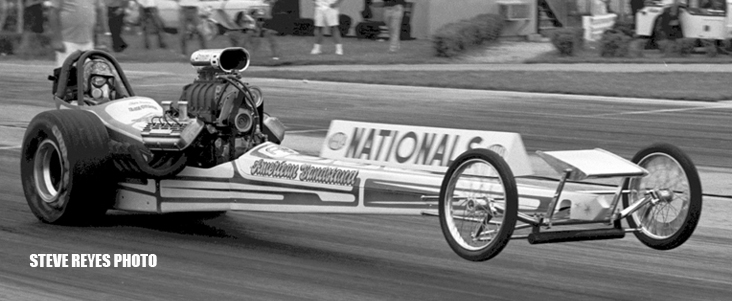
Colson and Peterson landed a sponsorship with Dick Clark’s popular American Bandstand TV show for the 1970 NHRA U.S. Nationals and later drove for the famed Minneapolis-based Hoover family in the 1971 season.
According to drag racing historian and longtime Colson friend Bret Kepner, whose authoritative bio of Colson was instrumental in today’s column, “Colson had been a vocal opponent of Funny Cars for several seasons,” but ended up driving one of the most famous of the breed, the Chi-Town Hustler, after Clare Sanders vacated the cockpit before the 1972 season.
According to Austin Coil, Sanders, just the second driver in Chi-Town history behind Pat Minick, quit without much notice, but Minick knew Colson from their UDRA days and suggested him as a replacement (well-known Chicagoland UDRA Top Alcohol Funny Car standout Fred Mandolini also was in the running, according to Coil). Despite never having driven a Funny Car, Colson adapted quickly.

“He never had any problem with those long burnouts we liked to do,” said Coil. “All he’d say was, ‘How far do you want me to go?’ When we did a PR burnout in front of Buckingham Fountain [in Chicago’s Grant Park], that was basically on a sidewalk concrete, and fresh concrete is considerably more sticky than the average racetrack, but Colson had a real good feel for it. He was on the wood to keep the tires smoking; as he came by me, the [injector] blades were wide open, but he didn’t over-rev the motor. He was good at that.”
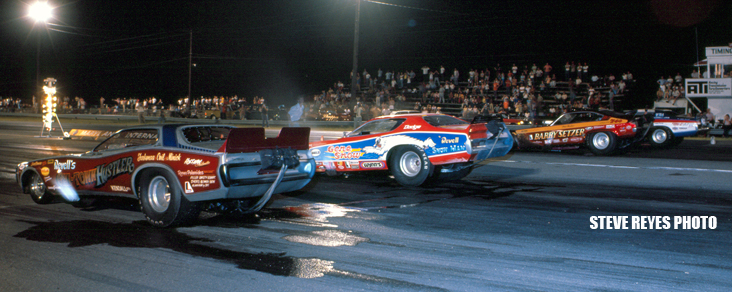
Check out this great Steve Reyes photo showing Colson as part of a four-wide Funny Car match race from Budds Creek, Md., in 1972. That’s Colson in the near lane alongside Gene Snow, Pat Foster in the Barry Setzer Vega, and Russell Long driving Charlie Proite's Pabst Blue Ribbon Charger.
The team was dominant not just on the match-race trail but also won the 1974 IHRA Funny Car world championship. Colson also was Coil’s constant traveling companion on the match-race scene, sharing driving duties on the team’s fabled ramp truck and helping coax it along as the odometer read well into six figures, including a memorable dropped-valve repair in a church parking lot in the middle of the night somewhere in Tennessee. Colson drove for the team through the end of the 1975 season before quitting; he was replaced by Denny Savage.

Colson started 1976 behind the wheel of the Chapman Automotive Chicago Patrol Funny Car, which was a promotional tool for the Chicago Police Department on a Mustang II equipped with working “bubblegum machine” police lights on the roof.
In mid-1976, Colson took over the controls of another famed Funny Car, Roland Leong’s storied Hawaiian, and became Leong’s longest-tenured driver. Between 1972-75, Leong had hired and (usually) fired six drivers (Leroy Chadderton, Gordie Bonin, Mike Van Sant, Denny Savage, Norm Wilcox, and Larry Arnold), but Colson was his guy through the end of the 1980 season.
The reason for Colson’s long tenure?
“Unlike most of my other drivers, he never tried to tell me how to run my car,” Leong told me earlier this week. “We worked together well. He was a good driver, and we got a couple of NHRA national event wins and won the Popular Hot Rodding [Championships], too.”
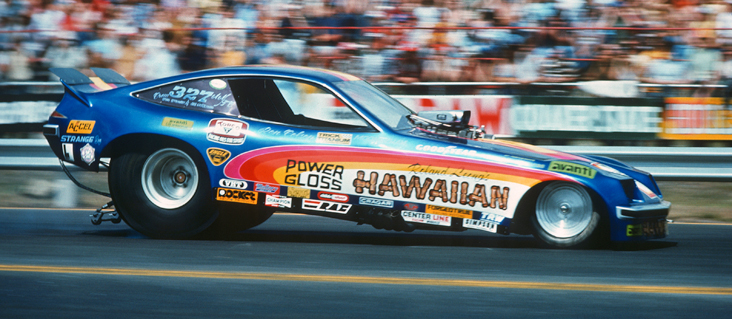
The late 1970s were some good years for the duo as they enjoyed corporate sponsorship from a number of companies. Colson drove Leong’s Power Gloss-backed Monza in 1977.
Avanti, a maker of citizen-band radio antennas, came on board in 1978 at the height of the CB craze and stayed with them through 1979. At the time, Colson was working in the marketing department at Chicago-based Avanti, and they often worked on the car at their headquarters. The company president happened upon them and asked for space on the side of the Power Gloss car. It started as just a small decal on a green stripe on the Power Gloss car, but the next year he bought the sponsorship for the entire car.
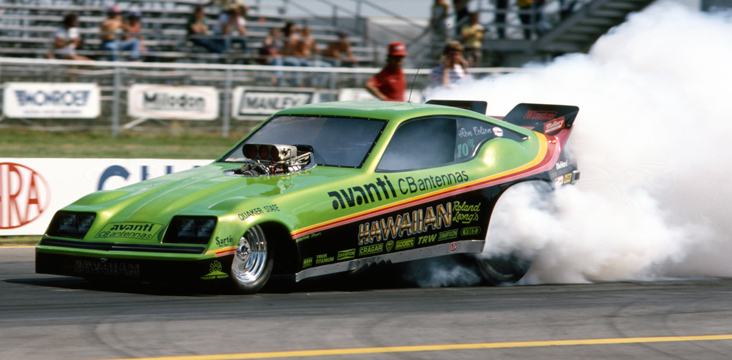
It was in the Avanti-backed Monza that Colson earned a dose of infamy at the 1978 U.S. Nationals when he crossed the centerline on a second-round bye run. His disqualification allowed Tom McEwen a test run in the semifinals that gave the fabled “Mongoose” the tune-up to famously beat Don Prudhomme in the emotional final round that came just weeks after McEwen’s young son, Jamie, had died of leukemia.
Although the popular story is that the Hawaiian turned left across the centerline due to a broken chassis, a piece of drag racing lore that has endured and only added to the fairy-tale story of McEwen’s win, Leong says that wasn’t the case.
“Ron did a great job driving for me, and only pissed me off twice,” said Roland. “I’m not sure where that [broken chassis] story came from but that never happened. He just lost control. The other time was at the 1979 World Finals [more on that later].
“If Ron didn’t make that mistake in Indy, there might not have even been a Snake & Mongoose movie,” he chuckled, referring not only to the opening scenes of the recent Hollywood biopic but the thread that ran throughout it.
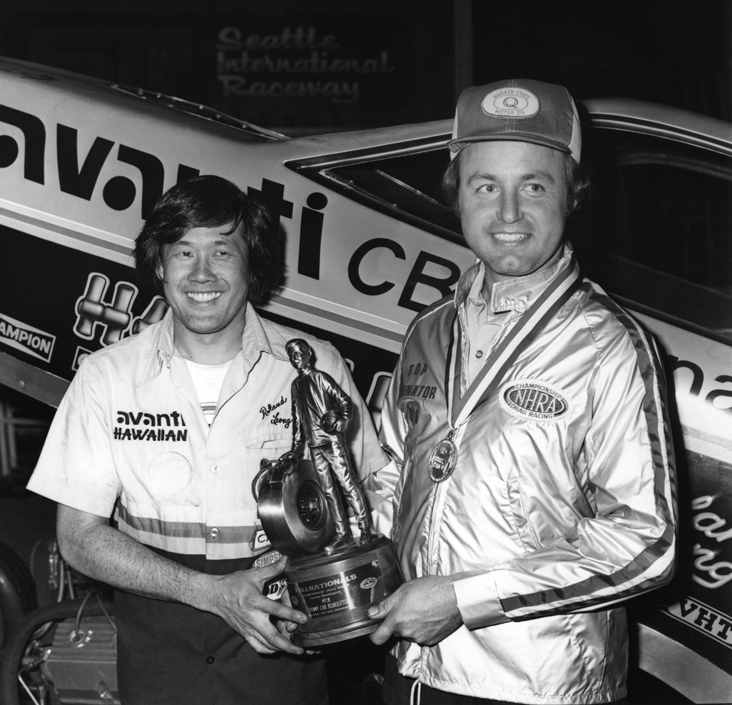
Colson made up for that missed Indy opportunity later that season when he drove the Hawaiian to victory at the NHRA Fallnationals in Seattle, where he defeated Dale Pulde in the final round. It was Leong’s first NHRA national event Funny Car win since Butch Maas piloted his entry to victory at the 1971 Winternationals, part of an amazing streak of Pomona wins by Leong.

The team switched to a Corvette in 1979, breaking two taboos (green car and the cursed Corvette) in one swoop, yet they still finished fifth in the 1979 NHRA World Championship battle. Colson’s other Leong misstep happened at the season-ending World Finals, which many may remember as being hampered by oil spilled on the track at a diesel truck race on the dragstrip the previous weekend that essentially turned it into a one-good-lane racetrack. Leong and Colson had all-important lane choice coming into the semifinals and probably would have won the race, according to Leong.

“The run before [the second round], the front end was in the air, and we won, but it was hairy. I wanted to put weight on the front end, but Colson talked me out of it. He pulled the front end up again in the semifinals, and he had to lift, and we lost. That’s the last time I’ve ever listened to a driver.”
According to Kepner, in 1979, Colson also founded Colson Communications, a firm that immediately found roots in television production of drag racing events. The company’s first production, a one-hour recap of the 1980 Popular Hot Rodding Championship, was syndicated nationally and gained attention for the brand.
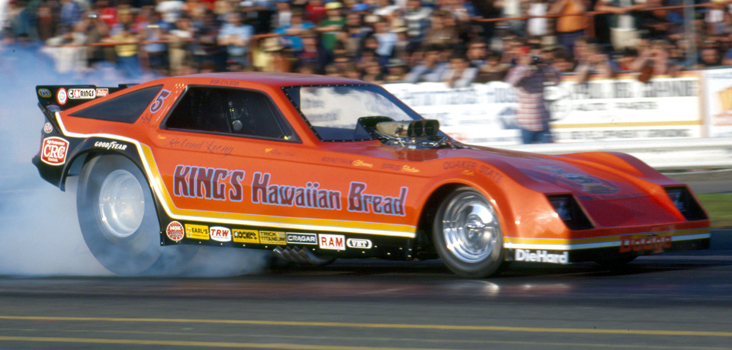
Leong landed a homestate-loyal sponsor in 1980 as King’s Hawaiian Bread came on board and remained with the team for a couple of years. Colson and Leong kicked off the season and the sponsorship with a Winternationals runner-up behind Pulde (revenge for Seattle!) in their new Dodge Omni (and ended the year in the winner’s circle with a victory at the NHRA World Finals at Ontario Motor Speedway in the posh venue’s last hurrah, lifting them to a third-place championship finish. Mike Dunn, who had driven the car on occasion in 1980 as a test driver, took over the car full time in 1981 as Colson moved on to a second career as a racing consultant and would-be media mogul.
Colson Communications morphed into Performance Communications and spread its wings to take over United Racer, the monthly newsletter of the United Drag Racers Association. With Kepner as his editor, the publication switched to a bi-weekly newspaper that covered every aspect of drag racing and became a respected voice as an independent publication.
According to Kepner, Colson’s increased visibility led him to become a trusted marketing advisor with companies such as the Petersen Publishing Company, Del Monte Foods, and Strange Engineering. Likewise, Colson became a sought-after counselor for track operators who needed insight into the many aspects of racing management. To fill this demand, Colson created Track Planning Associates in 1986. TPA, Inc., became a one-stop advocacy service that offered everything from permit gathering to environmental impact studies to track construction techniques to management seminars. To date, TPA, Inc., has assisted in the creation, opening, and operation of dozens of tracks across the country.
![]()
As previously mentioned, National Dragster Senior Editor Kevin McKenna got his start in the drag racing journalism business with Colson and United Racer and shared these memories with me.
“I was 18 when Ron Colson gave me my first break in the industry when he asked me to be the editor of United Racer. To this day, I’m not sure why he chose me, but I’m eternally grateful since it has ultimately led to a long career with NHRA.
“United Racer was known to many as the official publication of the United Drag Racers Association, but in reality, Colson wanted it to be neutral and cover the entire sport, so we endeavored to do just that. Most of the time, the staff was just three or four of us and the hours were long, and the pay was modest, but we managed to put out a publication that we could be proud of.
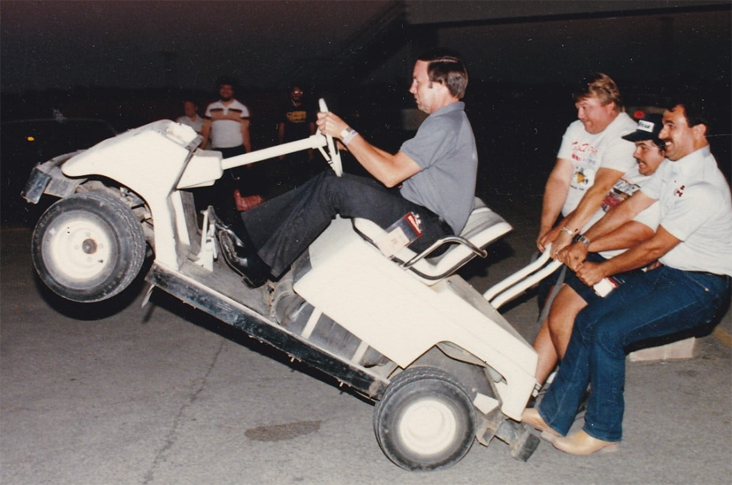
[Colson knew how to have fun, too. Here he is behind the wheel of a golf cart with Kepner (nearest), McKenna (middle), and Jeff Burk providing the ballast for an impressive pit-area wheelie.]
“I not only worked for Colson as the editor of United Racer, but also lived in his home outside of Chicago for nearly three years. To suggest it was a life-altering experience would be an understatement. Colson not only taught me about the publishing industry, but I also got an inside look at the lifestyle that defines most drag racers. Ron knew just about everyone in the industry, and they all knew him, so when the phone rang, you never knew who might be on the other end of the line.
“It wasn’t uncommon for someone like Roland Leong [Colson’s former employer and one of his closest friends] to bring his entire Hawaiian team to the house for a few days on their way to a match race in the Midwest. There was the time that Roland’s 18-wheeler ran through Colson’s prized flower bed or the numerous times the neighbors heard the sounds of a nitro engine being fired in the driveway. It was all part of the experience.
“With Colson, I also got an advanced education in Chicago drag racing. I got to see the tiny garage behind John Farkonas’ mother’s house where the Chi-Town Hustler was kept for many years and met Chris 'the Greek' Karamesines in his favorite hangout, JC’s Pub & Ristorante in McCook, Ill. If there was a place near Chicago that had any historical significance in drag racing, Colson knew about it.
“Running a small independent publication was often difficult, even in the days before the internet and social media, but I wouldn’t trade the experience for anything. Thank you, Ron, for believing in me. Rest in peace.”
And thank you, Ron, for being a part of our world.
Colson’s passing is not the lone loss to the sport over the last few weeks, as we also lost folks Tommy Johnson Sr., Paul Stage, Larry Adleman, and Ron Leaf.

I also was blessed to have a long friendship with Tommy Sr., best known to current fans as the father of modern-day Funny Car hero Tommy Jr. (and even the subject of a collective Finish Line trading card, above), but to those of us who have been around a while, he was a former drag racer and the down-home owner of a mail-order parts business that regularly ran ads in National Dragster. I remember him buying a huge ad — at least a spread, maybe even four pages — in the prized SEMA Show souvenir issue of ND with the big headline “Who am I and what am I doing here?” that helped introduce his business to those at the trade show who might not yet know his name.
Tommy Sr. also wrote an amazing book chronicling his self-cure to cancer, turning to a special diet rich in natural resources that saved a life doctors thought was beyond saving. It’s a legacy that will survive him.
Tommy Sr., who I saw not that long ago at the races cheering on his son, passed away after a couple of strokes. Reaching out to Tommy Jr. to offer my condolences, he summed up his father in just a few perfect words: “Nobody loved drag racing more than him, and he never met a stranger.”

Paul Stage’s name may be familiar to drag racing fans of the 1960s as he won a pair of NHRA national events in 1968, the first Springnationals in Englishtown (before E-Town got the Summernats and the Springs moved to Dallas and then Columbus) and the granddaddy of them all, the U.S. Nationals, with his dragster, which ran in Super Eliminator.
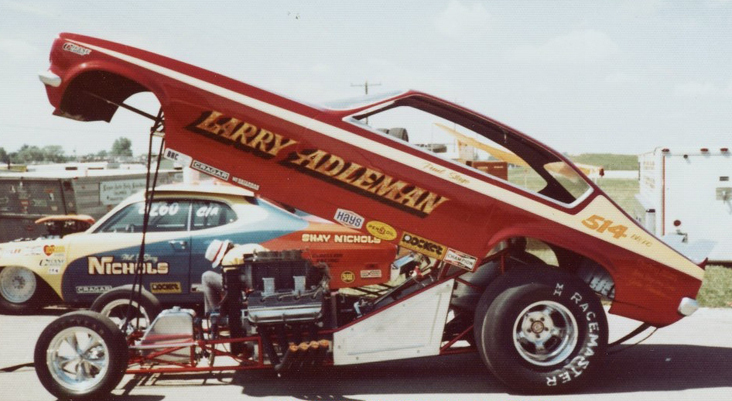
Adelman was an Alcohol Funny Car owner from the mid-1970s through mid-1980s, employing drivers including Stage, Marc Pieri, Tom Trisch, and Marc White.

Leaf is best remembered for his early 1960s-mid-1970s Funny Car career and most memorably his Chevy Vega pictured here.
All in all, a couple of tough weeks for drag racing fans. Remember to thank your heroes before it’s too late.
Phil Burgess can reached at pburgess@nhra.com
Hundreds of more articles like this can be found in the DRAGSTER INSIDER COLUMN ARCHIVE



















































